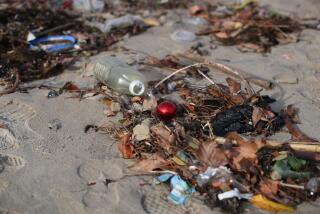Flowers at the Edge of Sea
They lay at the foot of the cliff like fallen flowers, amidst the flattened boulders and gentle surf, two young women who had given up on life.
Their names were Amber Hernandez and Alicia Hayes.
The likelihood is they had deliberately plunged to their deaths down the steep cliffside for reasons yet to be determined.
They were found a week ago, small bodies near the vast expanse of the ocean, at the point in San Pedro where Fermin Park juts into the sea.
While those who knew them weep and wonder, the girls vanish into a mass of statistics that register the suicides of 5,000 young people each year in a nation that is becoming increasingly dangerous for children.
Amber was 14, Alicia 15.
I visited the site of their deaths on a morning which, by its melancholy darkness, seemed to grieve for them. A cold, gray fog blanketed the shoreline like a funeral shroud, damping the hues of even the brilliantly colored bougainvillea that blossomed in the yards overlooking the Pacific.
I was drawn to the scene by both the deaths of the girls and by the suicides last March of two other young people, Christopher Mills and Heidi Chamberlain, both under 16, who had jumped into oblivion a few miles north.
Standing at the edge of the cliff, listening to the laughter of children from below that tinkled like wind chimes in the gray morning I wondered: What makes our kids decide to kill themselves?
*
The question evokes an unsettling memory. Years ago, at a camp in the Sierra Nevada, a young man I knew tried to hang himself from the rafters of a cabin a group of us were occupying.
We were 13-year-olds from poor families being taken on a weeklong outing in the mountains. There were a half-dozen of us in the cabin. It was night. We heard a noise from the corner bunk and flashed lights into the area.
What we saw in the confluence of our flashlight beams remains fixed in my mind: the boy hanging by his neck, his eyes staring into emptiness, his muffled sounds of strangulation filling the enclosure.
We cut him down and called for help. He recovered and weeks later I asked why he’d done that. He shrugged, smiled self-consciously and said, “I don’t know.” We never talked about it again.
Suicide is the third leading cause of death among teenagers in the nation, behind accidents and homicides. The American Assn. of Suicidology estimates that every hour and 40 minutes, a young person kills himself.
Why? I asked that question of Dr. Jay Nagdimon, the clinical psychologist who is director of the L.A. Suicide Prevention Center. The answers seem obvious: drugs, depression and a failure at interpersonal relationships.
But I suspect that at least part of what takes them to the edge of their lives is the violence that has permeated our society like an evil vapor.
Movies are violent, television is violent, music is violent, sports are violent. We blow up, stab, smash and shoot down to a degree never before witnessed at a single time in a single place.
By our obsession with violence, we make death seem easy. Even a kid can do it.
*
Thinking back, I suppose I went to the edge of the sea where Amber and Alicia had died because a few days earlier I had seen the flipside of youth in commencement exercises at Whittier College.
I was on stage at the ceremonies and could look across at a different sea: the faces of those about to leap not on to the rocks but into a future far from the cliffs of Point Fermin.
I heard the stories of their struggles and studied the faces of those who, despite everything, would not give up, who often clung to the edges of life by their fingertips, who bellowed defiance at despair.
I kept wishing as I shared in that moment with the graduates that I could have spoken to Alicia and Amber, and to Christopher and Heidi, before they crossed the dark barriers of their final decisions.
I wish I could have told them that there are ways out of misery, that those of us who have stood at the edge and turned back have tasted a sweetness of life that we otherwise would not have known.
It’s too late to tell them, but maybe you, out there, can tell your own kids. I have plans of my own. I’m going up north for a couple of weeks to see my friends Travis and Shana, who moved to Washington a few months back.
I’m going to hold them close, these two little wonders, and tell them about hope and love and the glory of life . . . and about some flowers that lay at the edge of the sea on a sad and overcast day in May.
*
Al Martinez can be reached through the Internet at al.martinez@latimes.com
More to Read
Sign up for Essential California
The most important California stories and recommendations in your inbox every morning.
You may occasionally receive promotional content from the Los Angeles Times.









